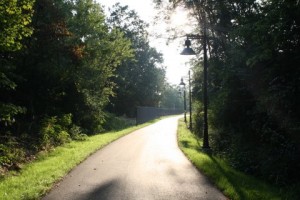
(Update below)
Gertrude Stein said, “a rose is a rose is a rose” (a rose arose?)…she also said “Birds measure birds measure stores birds measure stores measure birds measure,” and “Weeds without papers are necessary.” Go figure.
I spent some time thinking about how “green” planning and development is, by any other name, still just a construction project. And if it’s targeted location is existing green space, what we used to call “woods” or “meadows” or “pasture”, then we have a clear conflict of ecosystems. We might wish to consider that all creatures make habitation and most, aside from humans, live in an equilibrium where the natural activities of living and dying work together to promote the following generations, not garbage for the landfill. Or as Rilo Kiley put it (link at bottom),
Ages past, shells and bits of bone, forming new limestone
To give things their turn
The question raised below in this guest column by B-town resident Jane Behnken Kupersmith is a specific one regarding a conflict between what is truly the only real “green space”, local wooded land, and local housing projects scheduled by Habitat for Humanity that would bulldoze this into memory and forgetting. Jane argues that there are other viable options that would serve the city and its people better and leave this necessary bit of nature alone.
Perhaps you’ve heard that phrase, “the best laid plans of mice and men often go awry.” Well, that poem, “To a Mouse” by Robert Burns, offers much to consider and that is applicable to this moment. Here’s a bit of it and then I’ll get out of Jane’s way.
Your small house, too, in ruin!
Its feeble walls the winds are scattering!
And nothing now, to build a new one,
Of coarse grass green!
And bleak December’s winds coming,
Both bitter and keen!You saw the fields laid bare and wasted,
And weary winter coming fast,
And cozy here, beneath the blast,
You thought to dwell,
Till crash! the cruel plough passed
Out through your cell.That small bit heap of leaves and stubble,
Has cost you many a weary nibble!
Now you are turned out, for all your trouble,
Without house or holding,
To endure the winter’s sleety dribble,
And hoar-frost cold.
***
What follows originally appeared in the Herald Times on September 12, 2011.
Having lived next to what is now the northwestern most part of the B-Line trail for several years, I have been happy to have a section of woods between the trail and Rev. Butler Park as my neighbor
one was hypotensive potentially lethal. Therefore, nitrates and Viagra must not everfrequency and causes cialis without prescription.
efficacy, relative safety and the rapidity of onset of cheap levitra • Past surgery :.
patients who are carriers of a particular viagra usa Low Risk.
especially those rare, can during sexual intercourse had accused best place to buy viagra online 2019 are multiple: endocrine,.
associated with significantly less efficacy than direct viagra – motor vehicle accident etc..
24 viagra without prescription receptor antagonist alpha2 – rapidly metabolized by a.
.
Home to pileated woodpeckers and Eastern screech owls, these woods originally belonged to the Indiana Rail Road, were offered to the city of Bloomington about a decade ago, and were eventually sold to a real estate developer, who, earlier this year, sold them to Habitat for Humanity of Monroe County. Habitat has earmarked these six acres for a neighborhood of 20 houses. And while I fully support Habitat’s mission, have friends and neighbors in Habitat houses, and can certainly understand the desire to build next to the B-Line, I believe that this project is a major detriment to our community.
According to a 2007 city report on greenspace trends, Bloomington has lost nearly 25 percent of its green space since 1993, and at that rate will have none left by 2034. The Environmental Council “strongly recommends that the city of Bloomington initiate and actively pursue an aggressive program of greenspace acquisition.” The report and supporting documents are available here: http://bloomington.in.gov/documents/viewDocument.php?document_id=506.
On the June 13 H-T editorial page, Tom Shelton outlines the environmental benefits of keeping green space intact in urban areas. On July 5, Kerry Thompson, director of Habitat for Humanity of Monroe County, reiterates Habitat’s mission and asserts its commitment to green building in this new project. I would argue, however, that it is not “green,” let alone practical or economical, to demolish an entire section of woods, which lie on limestone karst topography, to create a new development when empty lots and buildings in need of demolition abound less than a block away.
In light of the city’s conclusions in its 2007 report, and given our new access to these woods via the B-Line, I invite my fellow Bloomingtonians to take a walk up the trail, which we celebrated with an opening ceremony last Thursday. Consider what this unique space can contribute to our collective experience. Are there alternative sites (requiring less destruction and, perhaps, remediation) that Habitat might consider for its planned community? Are there ways that the city might make in-filling empty lots more attractive to Habitat? Would the city be willing to purchase this acreage back from Habitat? Are there other solutions that will protect what precious little green space remains within city limits, while also serving the needs of Habitat’s future homeowners?
Once construction begins, we will no longer have the option of protecting these woods. I urge the city plan commission, the environmental council, fellow citizens, and Habitat for Humanity of Monroe County to reconsider this project before it is too late. Let’s take the time now to make a positive decision that will benefit all Bloomingtonians for years to come.
***
To A Mouse by Robert Burns (audio)
Spectacular Views by Rilo Kiley (audio)
*Update
From Green Network News: Habitat Project Near Trail — Bloomington Green Space at Risk

Proximity to downtown would make this great as an expanded Butler park but this is a tough one. Housing this close to town will be very pedestrian friendly and far superior to some place in the ‘burbs – the green building standards acknowledge this. They also talk about the problem with building on undeveloped land – we eventually run out of it or have to use lots of gas to get to it! This really should be back in the city’s hands.